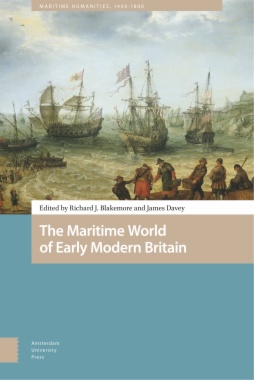Britain's emergence as one of Europe's major maritime powers has all too frequently been subsumed by nationalistic narratives that focus on operations and technology. This volume, by contrast, offers a daring new take on Britain's maritime past. It brings together scholars from a range of disciplines to explore the manifold ways in which the sea shaped British history, demonstrating the number of approaches that now have a stake in defining the discipline of maritime history. The chapters analyse the economic, social, and cultural contexts in which English maritime endeavour existed, as well as discussing representations of the sea. The contributors show how people from across the British Isles increasingly engaged with the maritime world, whether through their own lived experiences or through material culture. The volume also includes essays that investigate encounters between English voyagers and indigenous peoples in Africa, and the intellectual foundations of imperial ambition.
- Cover
- Table of Contents
- Acknowledgements
- Note on Conventions and Terminology
- Introduction
- Richard J. Blakemore and James Davey
- 1. The Minion and Its Travels: Sailing to Guinea in the Sixteenth Century
- 2. Commanding the World Itself: Sir Walter Ralegh, La Popelinière,
and the Huguenot Influence on
Early English Sea Power
- 3. An Investigation of the Size and Geographical Distribution of the English, Welsh, and Channel Islands Merchant Fleet: A Case Study of 1571–72
- Craig L. Lambert and Gary P. Baker
- 4. An Evaluation of Scottish Trade with Iberia during the Anglo-Spanish War, 1585-1604
- 5. Performing ‘Water’ Ralegh: The Cultural Politics of Sea Captains in Late Elizabethan and Jacobean Drama
- 6. ‘Wicked Actions Merit Fearful Judgments’: Capital Trials aboard the Early East India Company Voyages
- 7. ‘A water bawdy house’: Women and the Navy in the British Civil Wars
- 8. ‘Thy sceptre to a trident change / And straight, unruly seas thou canst command’: Contemporary Representations of King Charles I and the Ship Money Fleets within the Cultural Imagination of Caroline England
- 9. ‘Proud Symbols of the Prospering Rural Seamen’: Scottish Church Ship Models and the Shipmaster’s Societies of North East Scotland in the Late 17th Century*
- 10. Systematizing the Sea: Knowledge, Power and Maritime Sovereignty in Late Seventeenth-century Science
- Select Bibliography
- About the Contributors
- Index
- List of illustrations
- Figure 1.1: The Minion, Anthony Roll (1546). British Library Additional MS 22047, after C.S. Knighton and D.M. Loades (eds), THE ANTHONY ROLL of Henry VIII’s Navy. Pepys Library 2991 and British Library Additional MS 22047 with related documents, Occasion
- Figure 8.1: John Payne, Sovereign of the Seas (1637), © National Maritime Museum, Greenwich, UK.
- Figure 8.2: John Webb, Design for a triumphal arch, Temple Bar, London (1638), © RIBA Collections.
- Figure 8.3: Inigo Jones’s sketch for the relief carved spandrels for the proposed triumphal arch at Temple Bar, London (1636), © RIBA Collections.
- Figure 8.4: Detail of King Edgar on horseback, from John Payne, Sovereign of the Seas (1637),
© National Maritime Museum, Greenwich, UK
- Figure 8.5: Robert Ward, Animadversions of Warre (London: 1639), frontispiece and cameo detail. © The British Library Board
- Figure 8.6: Peter Pett and the ‘Sovereign of the Seas’ (1637), © National Maritime Museum, Greenwich, London. Detail of the ship’s stern and the figure of Victory
- Figure 8.7: Design for the Palace of Fame, from the courtly masque ‘Britannia Triumphans’, 1637 (pen & ink on paper), Jones, Inigo (1573-1652) / © The Devonshire Collections, Chatsworth / Reproduced by permission of Chatsworth Settlement Trustees / Bridge
- Figure 8.8: Masquer with feathers and plume (pen & ink on paper), Jones, Inigo (1573-1652) / © The Devonshire Collections, Chatsworth / Reproduced by permission of Chatsworth Settlement Trustees / Bridgeman Images.
- Figure 8.9: Francis Knight, A Relation of Seaven Yeares Slaverie Under the Turkes of Argeire (London: 1640), frontispiece and title page, Beinecke Rare Book and Manuscript Library, Yale University.
- Figure 8.10: ‘Charles I King of Great Britain and England’, © Getty Images.
- Figure 9.1: The Schip model on display in Aberdeen Maritime Museum © Aberdeen Art Gallery & Museums Collections
- Figure 9.2: The Schip model in the offices of the Aberdeen Shipmaster Society © Aberdeen Art Gallery & Museums Collections
- Figure 9.3: The Schip model before being restored, c.1981 – stern view © Aberdeen Art Gallery & Museums Collections
- Figure 9.4: Burntisland Parish Church interior (author’s own)
- Figure 9.5: Aberdeen Shipmaster Society of mortification © Aberdeen Art Gallery & Museums Collections
- Figure 9.6: Sixteenth century Dutch pulpit at Bo’ness Old Kirk (author’s own)
- Figure 10.1: Frontispiece of Francis Bacon’s Instauratio Magna (London: 1620).
© The Trustees of the British Museum. All rights reserved
- Figure 10.2: Robert Hooke’s Diagram of Hydrography, MS Rawlinson, A. 171, ff. 245v-246r, The Bodleian Libraries, University of Oxford
- List of Tables
- Table 3.1 Regional Distribution of English and Welsh Merchant Fleet:Michaelmas–Michaelmas 1571–7244
- Table 3.2 Ports within Regions with the Most Ships
- Table 3.3 Ports within Regions with the Greatest Tonnage

